Archive for the 'Board Game Review' Category
Posted by James (admin) on 21st August 2013
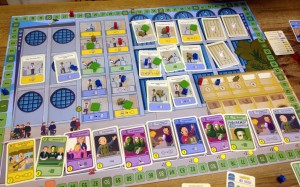 Friedmann Friese’s game of Copycat has the players trying to win votes in an election and which knowingly uses game mechanics from Dominion, Through the Ages and Agricola (with permission from their respective designers too). I’m always interested in Friese’s designs as there’s usually some unusual game mechanic or twist within them – they don’t always work for me but they’re much more often hits than misses.
Friedmann Friese’s game of Copycat has the players trying to win votes in an election and which knowingly uses game mechanics from Dominion, Through the Ages and Agricola (with permission from their respective designers too). I’m always interested in Friese’s designs as there’s usually some unusual game mechanic or twist within them – they don’t always work for me but they’re much more often hits than misses.
Essentially, Copycat game is a mix of worker placement and deck building. The player that gains the most votes (VPs) by the end of the game wins and the game ends after 10 rounds or when specific final cards have been bought. Each player has their own deck of cards (identical at the start) and each round players draw 5 cards from their decks. Each card has a number on it and, the first action of each round, is to simultaneously discard one card using the number on it to determine turn order. More powerful cards have higher numbers, so you have to balance using a good card to go first against using a card for its more powerful effect. Read the rest of this entry »
Tags: Copycat, Friedmann Friese
Posted in Board Game Review, Board Games, Copycat | No Comments »
Posted by James (admin) on 19th August 2013
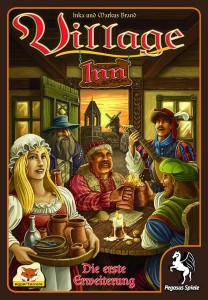
I really like Village as a game – it has you juggling lots of things at once without enough time or resources to do everything; you have to think about the other players who may take the actions/resources you want before you do so you have to prioritise what you take first and maybe alter your plans on the fly if someone has now taken something you were going to; and, players sometimes kill off their villagers on purpose so they can grab their points scoring positions in the village’s journal and by doing so means you have to watch out for the game ending sooner than you think or want. This makes a very entertaining game and I was glad it deservedly won the Spiel des Jahres last year. (The following assumes you know about the Village base game – if not, you can read my review of it here.)
As I liked the main game, I was pleased to hear there would be an expansion. However, I have realised over the years that the majority of expansions (especially for non-narrative games) end up adding more noise than gameplay – some friends and I worked out recently that we usually buy expansions because we’d like to see extra variety, but then more often end up playing the base game without the expansion because it’s usually tighter. So, into which of these categories was Village’s expansion (called Village Inn) going to fall? Read the rest of this entry »
Tags: board game news, Board Games, board gaming, Pegasus Spiele, SdJ, Spiel des Jahres, Village, Village Inn
Posted in Board Game Review, Board Games, Village, Village Inn | No Comments »
Posted by James (admin) on 19th July 2013
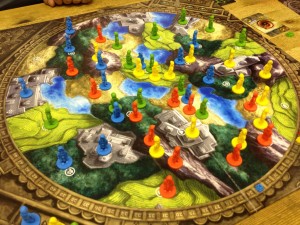 Aztlán is an area-control game which looks innocent on the surface but, underneath, there’s the constant lure to sabotage your opponents which can be devastating – which is one aspect that attracted me to the game. Plus, it’s by Leo Colovini and I find I like his games (Atlantis, Masons, Clans, Carolus Magnus).
Aztlán is an area-control game which looks innocent on the surface but, underneath, there’s the constant lure to sabotage your opponents which can be devastating – which is one aspect that attracted me to the game. Plus, it’s by Leo Colovini and I find I like his games (Atlantis, Masons, Clans, Carolus Magnus).
Each player is an Aztec tribe and the board shows a land divided into territories and each territory has a terrain type (jungle, mountains, etc.) The game lasts 5 rounds (Ages) during which players take turns, and the player with the most victory points (VPs) at the end of the game wins. On their turn, a player must place 1 of their people figures into the board, plus the player can optionally move 1 of their figures on the board to an adjacent region. Figures can be placed in, and moved to, any region even if opponents’ figures are there. Not many figures get placed each round (in a 4-player game, each player places 7 in the first Age and then one fewer each round after that so only 3 figures in round 5).
So far, the game may sound very ordinary; however, there are two game mechanics which define the game and make it entertainingly different: Power Cards, and the choice whether to Battle or Coexist. Read the rest of this entry »
Tags: Aztlan, board game news, Board Games, board gaming
Posted in Aztlan, Board Game Review, Board Games | No Comments »
Posted by James (admin) on 16th July 2013
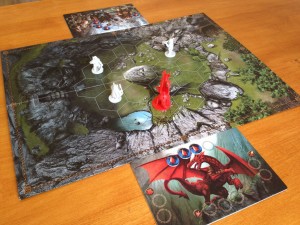 Drako is a 2-player, card-driven game by the designer who created K2 and The Cave. In Drako, 3 dwarves are pitted against one dragon with players taking turns drawing and playing cards from their hand.
Drako is a 2-player, card-driven game by the designer who created K2 and The Cave. In Drako, 3 dwarves are pitted against one dragon with players taking turns drawing and playing cards from their hand.
The two sides play very differently as each has their own specific deck of cards, plus the dragon is a single powerful figure which can fly around the board, use fiery breath and attack using powerful claws, whereas the 3 dwarf figures attack with their axes as well as each having their own special ability such as a crossbow or net. The game board shows a small hex-based grid which is the arena where the fight will take place.
Each turn, a player gets to perform 2 actions: Draw 2 cards or play 1 card. (Players have a hand limit of 6 cards.) Some cards display more than 1 option but a player can only 1 of the card’s options when played. For example, dwarf options include move 1 dwarf, move 2 dwarves, attack with 1 dwarf, attack with 2 dwarves, defend, use crossbow, and use net. Each move and attack icon has a value next to it which determines the amount of movement or power of the attack. When dwarves attack, they need to be adjacent to the dragon which is dangerous because the dragon could strike on its turn. Each dwarf has a special ability – one can use the crossbow, one can throw a net (which stops the dragon from moving until they spend a full turn escaping it), and one can give the dwarf player 3 actions during a turn once per game. Read the rest of this entry »
Tags: board game news, Board Games, board gaming, Drako, Rebel.pl
Posted in Board Game Review, Board Games, Drako | No Comments »
Posted by James (admin) on 15th July 2013
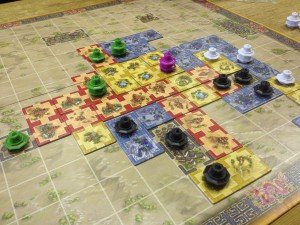
Note: The right-hand village should be owned by the white pagoda player as there are 3 white pagodas connected to it compared to 2 black pagodas.
Qin is a tile-laying game with a Chinese theme by Reiner Knizia. The winner is the first player to place all of their pagodas and players place pagodas on coloured territories they have created, so the game is about area control.
Players take turns placing 1 of the 3 tiles in their hand on the board next to any of the existing tiles. Each tile has 2 squares on it and each square can be red, yellow or blue. If a player creates a new contiguous territory of any single colour that consists of 2 squares or more, then they can claim that territory and place one of their pagodas on it. If a territory reaches 5 or more squares in size, then the owner adds a second pagoda to it.
If a tile joins two or more territories of the same colour together, then owner of the new large territory is the player who owned the most of the squares being combined. Territories of 5+ in size can never be merged.
Also on the board are some fixed black squares which are villages and these can be owned too. All the pagodas on territories that directly touch a village are added together – the player with the highest number places one of their pagodas on the village too. The pagoda on a village can change if the neighbouring territories change in a way to alter the totals and new clear winner emerges. Read the rest of this entry »
Tags: board game news, Board Games, board gaming, Knizia, Qin, Reiner Knizia
Posted in Board Game Review, Board Games, Essen Spiel 12, Qin | No Comments »
Posted by James (admin) on 14th July 2013
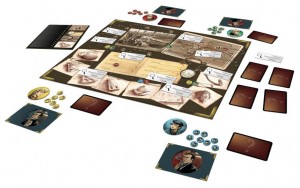 In Lady Alice, players are the kids on Baker Street who are trying to solve the kidnapping of explorer Stanley with Sherlock Holmes’s guidance. With that said, you’ll be unsurprised that Lady Alice is a deduction game.
In Lady Alice, players are the kids on Baker Street who are trying to solve the kidnapping of explorer Stanley with Sherlock Holmes’s guidance. With that said, you’ll be unsurprised that Lady Alice is a deduction game.
A crime has been committed and there are 4 pieces of information (categories) to work out: Where, Who, When and What. There are 8 different possibilities (clues) in each of the 4 categories (and there’s a card for each of the 32 clues). In the middle of the table is a board which shows Sherlock Holmes’s desk where all of the clues are displayed. (I’ll describe how the game plays with 4 players as it’s the most straightforward.)
At the start of the game, one card from each of the 4 categories is randomly drawn face-down – these 4 cards are the solution to the crime which are shuffled up and each player is dealt one at random. So, each player holds one of the 4 pieces of evidence and players don’t even know which category each of the other players holds. Read the rest of this entry »
Tags: board game news, Board Games, board gaming, Hurrican, Lady Alice
Posted in Board Game Review, Board Games, Lady Alice | No Comments »
Posted by James (admin) on 11th July 2013
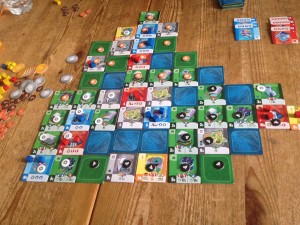
In City Tycoon, players are building different building tiles in the same city. The player with the most victory points (VPs) when the game ends after 4 rounds is the winner. The city starts with several fixed tiles in the middle including a small power and small water plant which are neutral.
Each of the 4 rounds is split into 3 main phases: Selecting tiles, Building/Selling tiles, and Activating tiles. The tile selecting phase starts with each player being dealt 6 building tiles – players look at them, keep 1 tile and pass the rest to the player on their left. This process happens 6 times with each player picking 1 tile from those they were passed, so each player ends with 6 tiles, as well as knowledge of what other tiles other players will have this round.
During the building/selling tiles phase, players take turns using 1 building tile from their hand in one of 3 ways:
- Build: The player pays the cost of the tile, places the tile in the city (next to any existing tile) and places a marker on it to show they own it. (Some buildings even generate cash, VPs, etc. when they are built too.)
- Sell: The player discards the tile and receives $5.
- Plant: The player discards the tile and can build the next available power or water generating plant tile (paying the cost marked on the plant tile and placing a marker on it to show they own it).
Finally, players take turns activating one of the building tiles they own to gain the benefit shown on the tile. Read the rest of this entry »
Tags: board game news, Board Games, board gaming, City Tycoon, Essen, Rebel.pl, Spiel 2012
Posted in Board Game Review, Board Games, City Tycoon, Essen Spiel 12 | No Comments »
Posted by James (admin) on 19th June 2013
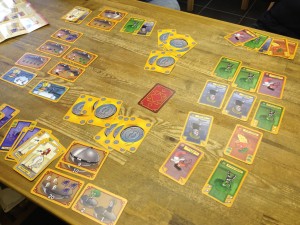 We Will Wok You is a quick card-game for 2-4 players. The theme is that the players are providing food at a music concert. On the table are recipe cards and ingredient cards. Each ingredient card shows one ingredient as well as one or two symbols (bowl, chopsticks, etc.) Recipe cards show how the player that owns the card can score victory points (VPs) at the end of the game and the player with the most VPs wins.
We Will Wok You is a quick card-game for 2-4 players. The theme is that the players are providing food at a music concert. On the table are recipe cards and ingredient cards. Each ingredient card shows one ingredient as well as one or two symbols (bowl, chopsticks, etc.) Recipe cards show how the player that owns the card can score victory points (VPs) at the end of the game and the player with the most VPs wins.
At the start of the game, 4 coin cards are placed next to 2 rows of 2 ingredient cards, and 6 coin cards are placed next to 2 rows of 3 ingredient cards – the coins indicate the price of the rows that they are next to. On their turn, a player must do one of three actions:
Buy ingredients: The player pays coins equal to the number of coins next to the row purchased. New ingredient cards are drawn to replace the bought row and the spent coins are added to the price. As a result, buying a row of ingredients raises the price of the ones that replace those bought as well as the other row of the same length.
Take a coin: The player takes one of the coin cards that show the prices of the ingredients. Taking a coin means some ingredients will be cheaper for the next players.
Gain a recipe card: The player places cards from their hand onto the table which have a total of 4 matching symbols (the ingredients on the cards are not important for this) and this allows the player to take any one of the remaining recipe cards. Read the rest of this entry »
Tags: board game news, Board Games, board gaming, Pegasus Spiele, We Will Wok You
Posted in Board Game Review, Board Games, We Will Wok You | No Comments »
Posted by James (admin) on 13th June 2013
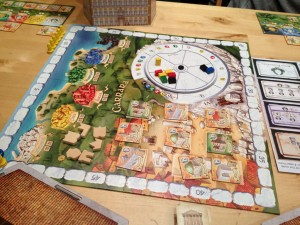 The Palaces of Carrara first caught my attention because it’s a Eurogame by veterans Wolfgang Kramer and Michael Kiesling (Tikal, Tikal II, Asara). Also, the Palaces of Carrara has been nominated for the 2013 Spiel des Jahres Kennerspiel.
The Palaces of Carrara first caught my attention because it’s a Eurogame by veterans Wolfgang Kramer and Michael Kiesling (Tikal, Tikal II, Asara). Also, the Palaces of Carrara has been nominated for the 2013 Spiel des Jahres Kennerspiel.
Players buy coloured marble which they use to build buildings in the 6 cities. The player with the most victory points (VPs) at the end of the game is the winner. This may sound very ordinary, but there are several clever game mechanics that combine really well and deliver a tight and tense game.
On their turn, a player can either buy marble, build a building, or score.
Buying Marble
On the board is a rotating disc (split into 6 segments). Around the disc are 6 sets of prices for the different marble colours – white is most expensive, then yellow, then red, and so on. When buying marble, the player turns the wheel one section clockwise and draws marble blocks from the bag to bring the total on the wheel up to 11 (placing new blocks in the most expensive segment). The player can then buy any number of marble blocks but only from one single segment of the wheel. The costs are marked next to each segment and these get cheaper (even free) as blocks progress around the wheel. Read the rest of this entry »
Tags: Asara, board game news, Board Games, board gaming, Hans im Glück, Michael Kiesling, SdJ, Spiel des Jahres, The Palaces of Carrara, Tikal, Tikal II, Wolfgang Kramer, Z-Man Games
Posted in Board Game Review, Board Games, The Palaces of Carrara | No Comments »
Posted by James (admin) on 11th June 2013
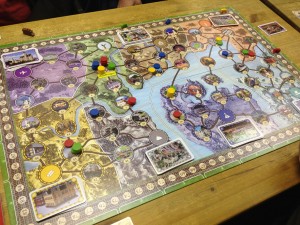 Wunderland is a game set at the massive, real-world, model village in Germany which covers 1,300 square metres. Players aim to earn the most victory points (VPs) by completing destination tickets and collecting postcards – the player with the most VPs at the game’s end wins.
Wunderland is a game set at the massive, real-world, model village in Germany which covers 1,300 square metres. Players aim to earn the most victory points (VPs) by completing destination tickets and collecting postcards – the player with the most VPs at the game’s end wins.
Each player has 8 visitor tokens and these all start on the main start space. The board shows lots of numbered spaces (locations) which are linked by various pathways and are located in 8 different regions (such as Hamburg, Austria, Scandinavia, USA). On their turn, a player can move any number of their visitors from one single location to another location that is 1 or 2 locations away (so a player can leave some of their visitors behind if they want); then, each other player can choose to move some of their visitors with those that were moved (if they had any on the same location).
This is a nice and simple game mechanic. Players can move their visitors quite quickly if they tag along with each others’ visitors, but players can also go their own way and be on their own spaces so they don’t benefit anyone else when they move. It’s a double-edged sword – you don’t want to help other players move towards their goals, but you want to tag along with other players when they move. Also, this game mechanic keeps the game flowing very quickly (as a turn is short) and there is very little downtime (as players are very often involved in moves when it isn’t their turn). Read the rest of this entry »
Tags: board game news, Board Games, board gaming, Pegasus, Pegasus Spiele, Wunderland
Posted in Board Game Review, Board Games, Wunderland | No Comments »
 Friedmann Friese’s game of Copycat has the players trying to win votes in an election and which knowingly uses game mechanics from Dominion, Through the Ages and Agricola (with permission from their respective designers too). I’m always interested in Friese’s designs as there’s usually some unusual game mechanic or twist within them – they don’t always work for me but they’re much more often hits than misses.
Friedmann Friese’s game of Copycat has the players trying to win votes in an election and which knowingly uses game mechanics from Dominion, Through the Ages and Agricola (with permission from their respective designers too). I’m always interested in Friese’s designs as there’s usually some unusual game mechanic or twist within them – they don’t always work for me but they’re much more often hits than misses.








 The Palaces of Carrara first caught my attention because it’s a Eurogame by veterans Wolfgang Kramer and Michael Kiesling (Tikal,
The Palaces of Carrara first caught my attention because it’s a Eurogame by veterans Wolfgang Kramer and Michael Kiesling (Tikal, 